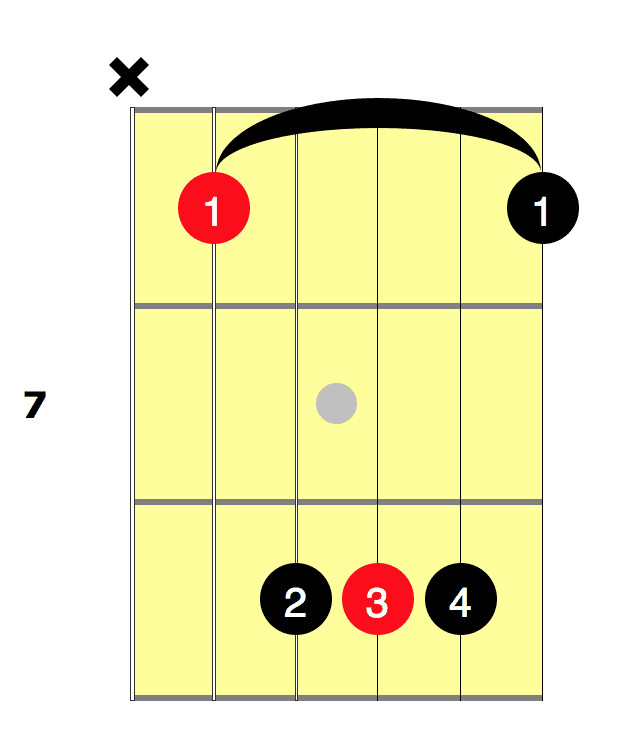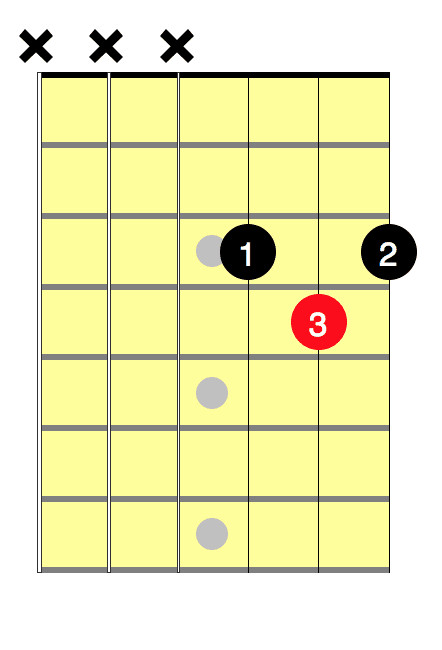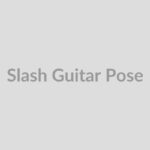The E flat guitar chord, often written as Eb, can initially feel a bit tricky for guitar beginners. However, it’s a crucial chord to learn as it appears in many popular songs across genres like jazz, pop, and rock. In this comprehensive guide, we’ll break down everything you need to know about playing the Eb chord on guitar, from basic shapes to helpful tips and tricks.
What is the Eb Chord?
The Eb guitar chord is a major chord. In musical notation, “flat” is represented by the symbol “♭,” but when we write chord names, we use a lowercase “b.” Therefore, E flat becomes Eb. Unless otherwise specified (like ‘Eb minor’ or ‘Ebm’), a chord named “Eb” is always a major chord. You might see it written in various ways:
- Eb Major Chord
- Eb Chord
- E Flat Guitar Chord
For clarity and to reinforce the note name, we’ll primarily refer to it as the “E Flat Guitar Chord” throughout this guide.
Popular Ways to Play the E Flat Guitar Chord
There are two primary ways to play the E flat guitar chord, both utilizing the barre chord technique. Mastering barre chords is fundamental to expanding your guitar vocabulary, and the Eb chord is an excellent place to start.
- E Shape Barre Chord: Based on the E major chord shape.
- A Shape Barre Chord: Based on the A major chord shape.
If barre chords are new to you, don’t worry! They require practice and finger strength, but with persistence, you’ll get there. Let’s explore both of these common Eb chord shapes.
Eb Guitar Chord (E Shape Barre Chord)
This shape is called the “E shape barre chord” because it’s formed by taking the shape of an open E major chord and moving it up the fretboard. The first finger acts as a ‘barre’, replacing the nut of the guitar to effectively shorten the string length and raise the pitch.
 E Shape Barre Chord for E Flat Guitar
E Shape Barre Chord for E Flat Guitar
Here’s how to form the E shape barre Eb chord:
- Barre at the 11th fret: Place your first finger across all six strings at the 11th fret. Ensure each string rings clearly. This is the barre.
- 3rd finger on the 13th fret of the A string (5th string): Use your third finger to fret the A string at the 13th fret.
- 4th finger on the 13th fret of the D string (4th string): Place your fourth finger on the D string at the 13th fret.
- 2nd finger on the 12th fret of the G string (3rd string): Fret the G string at the 12th fret with your second finger.
Strum all six strings to play the Eb chord. It’s crucial to ensure your barre finger is pressing down firmly enough for all strings to sound clearly without buzzing.
Eb Guitar Chord (A Shape Barre Chord)
The “A shape barre chord” for Eb is derived from the open A major chord shape. Again, we use a barre to transpose this shape up the neck to create the Eb chord.
 A Shape Barre Chord for E Flat Guitar
A Shape Barre Chord for E Flat Guitar
Here’s how to play the A shape barre Eb chord:
- Barre at the 6th fret (strings A to high E): Barre your first finger across the A (5th), D (4th), G (3rd), B (2nd), and high E (1st) strings at the 6th fret. You don’t need to barre the low E string for this chord shape, though you can mute it with the thumb of your fretting hand if desired to avoid accidental playing.
- 2nd finger on the 8th fret of the D string (4th string): Place your second finger on the D string at the 8th fret.
- 3rd finger on the 8th fret of the G string (3rd string): Fret the G string at the 8th fret with your third finger.
- 4th finger on the 8th fret of the B string (2nd string): Use your fourth finger to fret the B string at the 8th fret.
Strum from the A string (5th string) down to the high E string (1st string). This shape can be slightly easier for beginners as it requires barring fewer strings.
Easier Ways to Play the Eb Guitar Chord
Barre chords can be challenging initially. Thankfully, there are simplified versions of the Eb chord that are perfect for beginners or when you need a quicker, less demanding voicing. Let’s explore a few easy Eb chord variations.
1) Eb Guitar Chord (3-Finger Version)
This simplified Eb chord uses just three fingers and is a fantastic alternative, especially for beginners. It’s also a useful voicing for adding texture and dynamics to your playing.
- Simplicity: Only requires three fingers.
- Movable Shape: The same finger pattern can be moved to create other chords.
- Delicate Texture: This voicing has a lighter, more delicate sound compared to full barre chords.
To play this 3-finger Eb chord:
- 3rd finger on the 8th fret of the G string (3rd string): Place your third finger on the G string at the 8th fret.
- 4th finger on the 8th fret of the D string (4th string): Put your fourth finger on the D string at the 8th fret.
- 1st finger on the 4th fret of the high E string (1st string): Fret the high E string at the 4th fret with your first finger.
Strum only the D (4th), G (3rd), B (2nd) and high E (1st) strings. Avoid strumming the lower E and A strings for this voicing. This technique of selectively strumming strings is a valuable skill to develop.
2) Eb Guitar Chord (D Shape Variation)
This Eb chord variation utilizes a shape very similar to a D major chord. By simply moving the D chord shape up the fretboard to the 3rd fret, you create an Eb chord.
 A Shape Barre Chord for E Flat Guitar
A Shape Barre Chord for E Flat Guitar
Here’s how to play the D shape Eb chord:
- 1st finger on the 3rd fret of the G string (3rd string): Place your first finger on the G string at the 3rd fret.
- 2nd finger on the 3rd fret of the high E string (1st string): Put your second finger on the high E string at the 3rd fret.
- 3rd finger on the 4th fret of the B string (2nd string): Fret the B string at the 4th fret with your third finger.
Strum from the D string (4th string) down to the high E string (1st string). Like the 3-finger version, avoid strumming the lower strings for this voicing.
Tips for Mastering the Eb Guitar Chord
- Practice Barre Chords: If you’re struggling with the barre chord shapes, dedicate time to practicing barre chords in general. Focus on getting a clean sound from your barre finger. Exercises like barring across all strings and strumming each string individually can be very helpful.
- Finger Strength: Barre chords require finger strength. Regular practice will build the necessary strength over time. Don’t get discouraged if it feels difficult at first.
- Finger Placement: Ensure your fingers are positioned just behind the fret for optimal clarity and minimal buzzing.
- Start Slow: When learning new chords, start by practicing chord transitions slowly. Gradually increase speed as you become more comfortable.
- Use a Tuner: Always ensure your guitar is properly tuned. Playing chords on an out-of-tune guitar can make learning more difficult and frustrating.
- Break it Down: If a chord feels overwhelming, break it down into smaller steps. Practice just the barre first, then add fingers one at a time.
Conclusion
The E flat guitar chord is a valuable addition to your chord vocabulary. While barre chord versions might take time to master, the simplified voicings offer excellent alternatives for beginners and experienced players alike. By practicing these different shapes and focusing on the tips provided, you’ll be playing the Eb chord confidently and incorporating it into your music in no time. Keep practicing and enjoy the journey of learning guitar!


